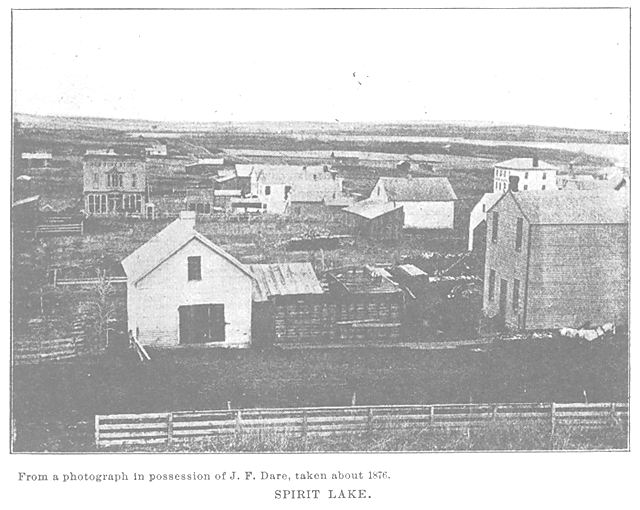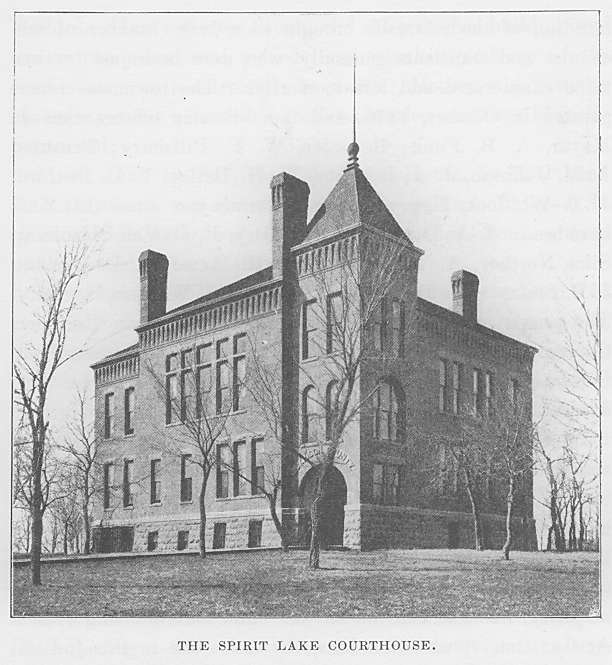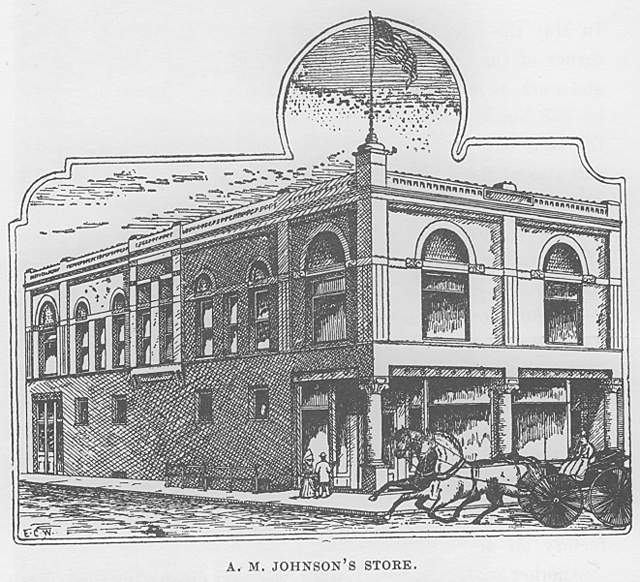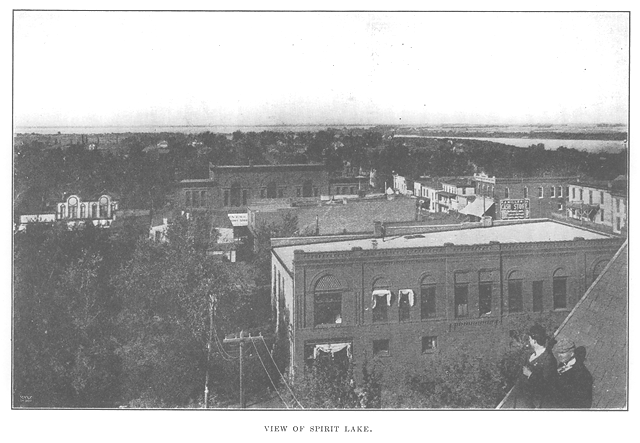CHAPTER XXXV.
SPIRIT LAKE TOWN CONTINUED—THE EARLY MERCHANTS—THE EARLY BUSINESS HOUSES GENERALLY—THE BEACON BLOCK—THE NEW CRANDALL HOUSE—THE COMING OF THE RAILROADS—THE ROLLER SKATE CRAZE—INCORPORATION OF THE TOWN—THE FIRST OFFICERS—THE NEW COURTHOUSE—THE FIRST BRICK BUILDINGS—THE STEVENS BLOCK—THE ELECTRIC LIGHTS—A. M. JOHNSON'S STORE— THE ROLLER MILL—THE COLD STORAGE PLANT.
IN MAY, 1877, C. S. Jones and J. A. Ellis formed a partnership for the general trade. Previous to this time each of them had been carrying on the grocery business "on his own hook," but now they consolidated and run a general store. They started in the old Baxter concrete, but finding that too much to one side, they soon moved up on Hill Street, and when the Beacon Block was completed in 1879, were the first to occupy the store rooms. They sold out in the spring of 1880 to F. W. Barron.
The fact that Snyder, Smith & Company started the first bank in the county has already been noticed. During the same summer B. B. Van Steenburg erected the small brick building on the north side of Hill Street, which lie afterwards used as a home for his bank. His card first appears in the paper August 23, 1877. These two institutions had their origin in grasshopper times and grew up side by side, until finally, after many changes and vicissitudes, the Snyder, Smith & Company Bank became merged in the Dickinson County. Bank and the Van Steenburg Bank the First National Bank of Spirit Lake.

Dr. E. L. Brownell purchased the Willard property in 1887 [sic] and commenced practice that season, dividing his time between Spirit Lake and Jackson. Later he improved a building which had originally been erected as a granary by putting on an addition and finished the whole off as a drugstore, where he commenced business in the summer of 1878, his advertisement first appearing in the issue of August fifteenth of that year, and it is only natural to suppose that it has appeared in every issue since, and may be considered the pioneer druggist of the county, as those preceding him had but imperfect stocks and remained in business but a short time. The old Willard store he used as a dwelling house until he built his residence in the vast part of town when the old store was torn down to make room for better improvements.
In the spring of 1877 T. J. Francis and S. P. Middleton erected a blacksmith and machine shop, making a specialty of wagon work and repairing farm machinery.
A. L. Sawyer and P. S. Mott were the first to start in the livery business, beginning in 1874. They were succeeded by Johnston & Gilbert the following year, who in addition to the livery business, had the Spirit Lake and Sibley and the Spirit Lake and Worthington stage lines.
C. H. Ayers was the pioneer insurance worker, he commencing as early as 1872 or 1873. Previous to that time but little had been done in insurance and that little by outside parties. Mr. Ayers was at the same time doing quite a stroke of business in farm machinery. A. L. Sawyer was at the same time working insurance and farm machinery, part of the time in connection with Mr. Ayers and part of the time on his own account. By thee way high freights and bad debts beat most of the early dealers in farm machinery.
After Mr. Bellows retired, Sam Campbell carried on the boot and shoe business. J. F. Dare was the pioneer furniture man and the first in the undertaking business. Fred Phippin was the first in the harness business, he having started a shop in 1878, and has stuck to it ever since when his health would permit. Various other business schemes were inaugurated about this time, but most of them were short-lived.
During the early days the legal profession was represented first by Orson Rice, who commenced practice as early as 1864, R. L. Wilcox in 1869, A. W. Osborne in 1870, J. W. Cory in 1874 and W. H. Bailey a few years later. There were others, but they came later or remained but a short time and can hardly be said to have worked up a practice.
The papers of this period mention several other business schemes and enterprises of minor importance, which have not been noticed in detail, which, though not very important in and of themselves, help to make up the sum total of the limited business that was possible under adverse circumstances.
Of course as the business increased, better buildings were required. The Beacon Block was erected in 1879 by H. L. Owens and was calculated to be a little ahead of anything, that had preceded it. There were three business rooms on the ground floor, one of which was occupied by the, Beacon office and the other two were finished off as store rooms, and mere first occupied by Jones & Ellis as a general dry goods store. The upper story was finished off as a music hall and opera house, and at that time answered very well the purpose for which it was intended. The building was known as the Beacon Block by reason of an arrangement made by Mr. Owen and the Beacon proprietors whereby the Beacon was to have permanent quarters in the building, and it was the desire of Mr. Owen that it should be called the Beacon Block. This arrangement remained in force until after Mr. Owen disposed of the property and the Beacon had secured quarters of its own. The building was shortlived and was torn down in 1893 to make room for the Stevens Block.
The old Crandall House, the hotel of the pioneer day ye; in 1880 moved back to make room for the present structure, Mr. Crandall having become interested in making improvements at the north side of the lake, the hotel property in town fell into the hands of T. L. Twiford, who moved back the old building and erected the new one on the same site. It was opened to the public in the spring of 1881. The old building being afterward torn down. Since the above was written the Crandall house has been torn down and the site cleared up preparatory to building a modern, first-class hotel, to cost about $40,000. This enterprise is being managed by Mr. J. Burmister.
In 1882 B. B. Van Steenburg and George Baxter erected the double building on the north side of west Lake Street and Van Steenburg moved his bank into the east room of the building, while the other was finished off as a drugstore. There were also other business buildings, together with numerous residences, but they cannot be noticed in detail.
The census of 1880 was the first in which the population was returned separate from the township at large. That census showed the population of the town to be 277. The Burlington, Cedar Rapids & Northern Railroad was built into Spirit Lake in July, 1882, and the Chicago, Milwaukee & St. Paul the following spring. Of course, from this time on things were changed. Each of the roads built commodious depots and stockyards, and warehouses and elevators were added when needed.
Two lumber yards had been started in anticipation of the completion of the roads, one by F. W. Barron and the other by D. L. Riley, both of which did a rushing business. Many new buildings were erected, both residences and business blocks. Indeed, there seems to have been a craze for business buildings, and more were erected, as it later proved, than were needed for the legitimate business of the town. The better ones and those in the more desirable locations were used in the business for which they were intended, but some of the cheaper ones have never been used at all except temporarily for store rooms, or something of that nature.
Many new firms appeared in the advertising columns of the paper in 1882 and 1883. J. A. Ellis about that time built what has since been known as the Dimond Store, and started again in business, but before he was fairly settled, he sold out his store and stock to John Dimond and soon afterward moved to Milford. Henry Baxter bought the old postoffice building and one or two others and moved them together, and out of the combination he constructed the Baxter House, which under his management achieved a good reputation and was liberally patronized.
About June 1, 1882, the Lake Park House, by R. P. and D. F. Lombard, was thrown open to the public. This was in times of high water, and the lake shore and boat landing there was supposed to be all that could be desired.
About this time the roller skate craze struck the town, and everybody skated. Two capacious skating rinks were built, the first one down by the lake near the bridge and the other just north of the Minnie Waukon Hotel. The craze lasted a year or two when it died out entirely. The rink down by the lake was afterwards converted into, a boat house, while the other one was torn down and the material used in the construction of a warehouse near the Burlington track.
The Beacon of December 29, 1882, in giving a summary of the improvements in town for the year, enumerates a list of one hundred and seventeen buildings erected or remodeled at a cost of nearly $110,000. In the course of the article it has the following: "We find that more than $28,000 have been invested in business houses, about $12,000 in hotel structures and upwards of $50,000 have been put into residences within the corporation."
By the census of 1885 the population was shown to be 751. Most of the increase came in 1882 and 1883. Indeed, most of the increase from 1880 to 1890 was in those two years. The census of 1890 showed a population of 782. This was disappointing, as it was but a small increase on that of five years before. Residences had gradually multiplied and it was supposed that the population had increased accordingly. That it did not is explained by the fact that the boom following the building of the railroads brought in a large number of mechanics and transients generally, who were here just in time to be enumerated and left soon after. The town was incorporated in October, 1879, and the following officers elected: Mayor, A. B. Funk ; Recorder, W. F. Pillsbury ; Trustees, A. M. Johnson, J. A. Doughty, W. H. Bailey, T. L. Twiford, J. T. Whitlock, Henry Baxter. The mayors since that time have been: J. A. Doughty, J. W. Cory, B. B. Van Steenburg, Silas Northey, A. W. Osborne, E. M. Betzer, E. D. Carlton, J. B. Stair, A. F. Bergman, V. A. Arnold, William Hayward. The present officers are: Mayor, A. W. Osborne ; Recorder, George F. Buck; Assessor, H. Van Steenburg; Trustees, S. L. Pillsbury, Leroy Davis, C. H. Stone, J. C. Davis, Marcus Snyder, A. Hurd.
In September, 1889, the question of issuing bonds to the amount of $15,000 for building, a new courthouse was submitted to a vote of the electors of the county, and carried by a fair majority, but there being some informality in the notice for the election, it was decided void by the court, but upon a second submission the previous vote was ratified by an increased majority, and the courthouse was built the following season. At that time it was considered the finest one in this judicial district. Larger and more expensive ones have since been built in neighboring counties, but none better in proportion to the cost. Many fine residences were erected and the appearance of the town was improved more than its growth in population would imply. In 1883 the old frame rattletrap which had gone by the name of a schoolhouse was torn down and in its place the present commodious structure was erected.

While the courthouse, schoolhouse and Methodist Church were of brick, there were as yet no business blocks of that material. The first one to be erected was by E. M. Betzer, on the northeast corner of Hill and Lake Streets. Since that time this block has been occupied by H. A. Miller, Jr., as a general store. About the same time E. L. Brownell, in connection with the Dickinson Bank, made substantial improvements on the southwest corner of the same streets. Indeed, Mr. Betzer and Mr. Brownell were the pioneers in starting the boom for better buildings and after it was once started others were quick to fall in. In 1893 B. F. Stevens, of St. Louis, who had previously erected a large cottage in the north part of town, decided to build a brick block on a more extensive and expensive scale than any of his predecessors. In pursuance of this plan he decided on the northwest corner of Hill and Lake Streets as being best suited for his use. The Beacon of February third has the following:
"Stephen Stevens, for his brother B. F. Stevens, of St. Louis, yesterday secured options for the purchase of the properties at the corner of Lake and Hill Streets, owned by Mrs. Abbie Rice, Marcus Snyder, William Hayward, F. F. Philpin and Mr. Ashby. This is a step preliminary to the erection of a solid brick block that shall cover the entire plat."
Two weeks later the Beacon says:
"With his lot purchase Mr. Stevens gets the Beacon Block, the Variety Store and the Snyder building. The first name will be torn down and the others moved to other sites."

The issue of March twentieth notes the execution of the plans, and says:
"They provide for five storerooms with basements of equal floor dimensions. On the corner is located the First National Bank, under which is planned an elegant barber shop with bath rooms; on the second floor, beginning at the alley on the west, are located rooms for the Masonic Lodge and next are quarters of equal dimensions for the Knights of Pythias. An opera house with a capacity for about four hundred seats comes next, and against the Hill Street side are located two elegant suites for office purposes."
The issue of April fourteenth notes the tearing down of the Beacon Block and the Snyder building to make room for the new improvements. Work was commenced, at once and the block was ready for occupancy about the first of February, 1894.
The first occupants were the First National Bank; Bergman & Farnham, drugs and groceries; E. C. Renken, drugs and stationery; John Dimond, general store, and Copley & Blackert, hardware. The opera house was opened on the evening of February twenty-fifth, by the Woodward Theatre Company, in the play of "The Galley Slave." The lodge rooms were occupied, as planned, by the Masons and the Knights of Pythias, and are still so occupied.
Closely connected with the building of the Stevens Block is the electric light enterprise. It was Mr. Stevens' design to heat his building by steam and light it by electricity. He accordingly submitted a proposition to the town council stating the conditions on which he would put in a plant of sufficient capacity for lighting the town and furnishing steam heat for several public buildings. His proposition was that he should be granted a twenty year franchise and assured that for three years he should receive $600 a year for street lighting at rates paid by Iowa towns of like character. Under the law such a proposition would have to be submitted to a vote before the council could act on it. The proposition was accordingly submitted, and out of a poll of two hundred and six votes there was but one cast against it. The plant was erected and so far completed that the light was turned on for the first time February 5, 1894. Six years later Mr. Stevens made an unconditional gift of the power house and the heating and lighting plant to the town, without any reservations or conditions whatever. In 1900 the Board of Supervisors arranged to have the courthouse heated by steam from the electric power house boiler. This plant is said to represent a value of about fifteen thousand dollars.

In the spring of 1894 Mr. A. M. Johnson decided to erect new quarters. The old store had been in use now twenty years, and although, when built, it was counted equal or superior to the best in this portion of the state, it now began to look a little shabby when compared with the recent structures. In May the old store was moved from its foundations to the corner of the courthouse lot on the opposite side of the street and work at once commenced. The new building is forty-five by one hundred feet and two stories, the lower story being fourteen feet in height and the upper one twelve ; basement full size of the building. The store room proper occupies the entire ground floor and is divided into three departments. The walls were up and the building under cover about the twentieth of September, and ready for occupancy about the first of December.
In 1898 Messrs. Lovesee and Hurd erected a first-class steam flouring mill. Their machinery was all new and of the most modern and improved variety. They spared no pains or expense to get the best that money would buy. They asked no bonus or subsidy, but simply stipulated with some of the more prominent business men that they should have their exclusive patronage so long as they produced as good an article as could be obtained elsewhere, and the result has proven entirely satisfactory all around.
Another of the later day improvements out of the ordinary in towns the size of Spirit Lake, is the cold storage plant. This is another enterprise of B. F. Stevens, and is far reaching in its scope and design. Indeed, there is nothing like it in this part of the state. In addition to the facilities usually furnished by cold storage plants for handling perishable goods, he had put in a butter renovator, whereby rancid butter is put through a process of renovation that so improves it that it requires an expert to detect the difference between this and the genuine creamery article. The entire product of this plant is shipped East and the demand is much greater than the supply.
